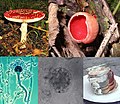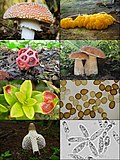Search results
Appearance
Did you mean: fiction fungi
The page "Fission-fungi" does not exist. You can create a draft and submit it for review or request that a redirect be created, but consider checking the search results below to see whether the topic is already covered.
- chemicals. Once regarded as plants constituting the class Schizomycetes ("fission fungi"), bacteria are now classified as prokaryotes. Unlike cells of animals...143 KB (15,534 words) - 20:00, 8 November 2024
- Fungus (redirect from Multicellular fungi)species grow as unicellular yeasts that reproduce by budding or fission. Dimorphic fungi can switch between a yeast phase and a hyphal phase in response...200 KB (19,205 words) - 21:46, 10 November 2024
- Fission, in biology, is the division of a single entity into two or more parts and the regeneration of those parts to separate entities resembling the...20 KB (2,184 words) - 00:26, 10 November 2024
- Schizosaccharomyces pombe (redirect from Fission yeast)southeast Brazil. The fission yeast S. pombe belongs to the division Ascomycota, which represents the largest and most diverse group of fungi. Free-living ascomycetes...52 KB (6,055 words) - 00:55, 14 August 2024
- Cell division (redirect from Asynthetic fission)and archaea) usually undergo a vegetative cell division known as binary fission, where their genetic material is segregated equally into two daughter cells...41 KB (4,735 words) - 07:20, 9 October 2024
- Ascomycota (redirect from Sac fungi)Archiascomycetes (or Archaeascomycetes). It includes hyphal fungi (Neolecta, Taphrina, Archaeorhizomyces), fission yeasts (Schizosaccharomyces), and the mammalian...54 KB (6,675 words) - 23:37, 28 October 2024
- Food spoilage (redirect from Fungi in food spoilage)for the consumption of humans is lost every year. Bacteria and various fungi are the cause of spoilage and can create serious consequences for the consumers...13 KB (1,580 words) - 20:49, 4 May 2024
- Dikarya (redirect from Higher fungi)Dikarya is a subkingdom of Fungi that includes the divisions Ascomycota and Basidiomycota, both of which in general produce dikaryons, may be filamentous...8 KB (514 words) - 23:22, 7 November 2024
- Caesium-137 (category Fission products)isotope of caesium that is formed as one of the more common fission products by the nuclear fission of uranium-235 and other fissionable isotopes in nuclear...36 KB (3,877 words) - 01:35, 12 November 2024
- as amoebae, or multicellular, such as some algae, plants, animals, and fungi. Eukaryotic cells contain organelles including mitochondria, which provide...60 KB (6,271 words) - 04:42, 20 August 2024
- and Ebriida). Protozoa mostly reproduce asexually by binary fission or multiple fission. Many protozoa also exchange genetic material by sexual means...52 KB (5,212 words) - 05:40, 27 October 2024
- ascomycetes and most lichenized fungi. It is more or less synonymous with the older taxon Euascomycota. These fungi reproduce by fission rather than budding. This...4 KB (335 words) - 00:21, 20 September 2024
- Saccharomyces is a genus of fungi that includes many species of yeasts. Saccharomyces is from Greek σάκχαρον (sugar) and μύκης (fungus) and means sugar...7 KB (672 words) - 21:01, 18 October 2024
- Asexual reproduction (section Fission)unicellular fungi) may reproduce in a functionally similar manner by mitosis; most of these are also capable of sexual reproduction. Multiple fission at the...51 KB (5,390 words) - 14:20, 11 November 2024
- Yeast (category Medicinal fungi)forms (depending on temperature or other conditions) are called dimorphic fungi. The yeast species Saccharomyces cerevisiae converts carbohydrates to carbon...92 KB (9,763 words) - 22:26, 29 October 2024
- number of microbial cells (bacteria, fungi, viruses etc.) in a sample that are viable, able to multiply via binary fission under the controlled conditions...22 KB (2,545 words) - 00:04, 10 September 2024
- Schizosaccharomycetes is a class in the kingdom of fungi. It contains the order Schizosaccharomycetales, the fission yeasts. The genus Schizosaccharomyces is a...1 KB (100 words) - 15:26, 28 October 2024
- and sea stars. Molds, yeasts and mushrooms, all of which are part of the Fungi kingdom, produce tiny filaments called hyphae. These hyphae obtain food...11 KB (1,134 words) - 09:00, 7 May 2024
- Soil biology (section Fungi)soil-litter interface. These organisms include earthworms, nematodes, protozoa, fungi, bacteria, different arthropods, as well as some reptiles (such as snakes)...24 KB (2,670 words) - 14:30, 4 October 2024
- Saccharomycetes—or budding fungi—of which the yeast-plant is typical; and others belong to the Schizomycetes, the fission fungi—bacteria, etc.—forms of which
- lushness and every leaf has its edging of crystal drops. Strangely colored fungi — mustard-yellow and apricot and scarlet — are pushing out of the leaf mold
- Chytridiomycota, the chytrids, represents a group of primitive aquatic fungi. They are characterized by having reproductive cells can move themselves














